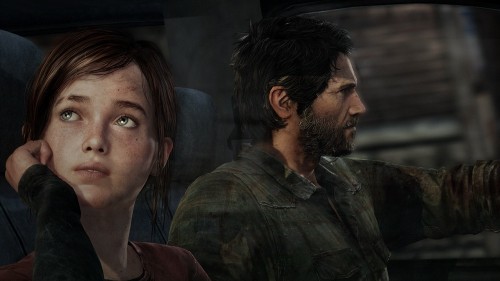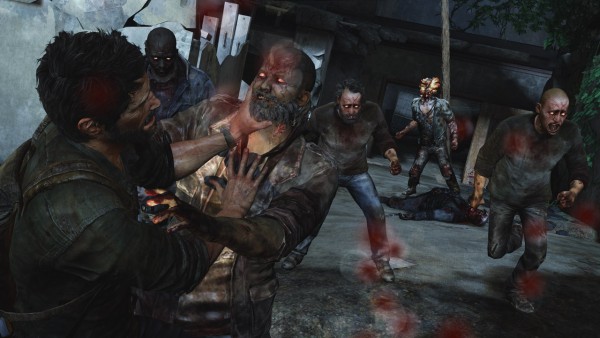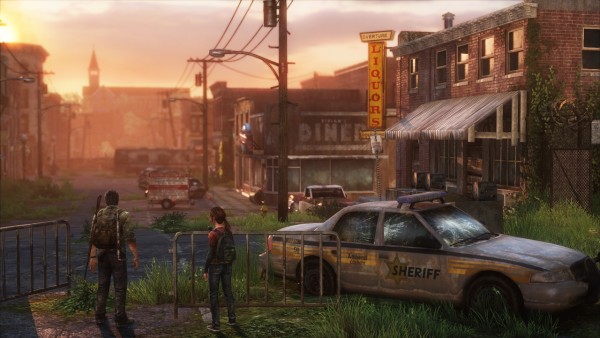The game centers around an aging Joel and 14-year-old Ellie as they travel to various parts of the United States in search for the Fireflies, a rebellion group hiding from government forces. In addition to meeting various characters along the way, a relationship between the two protagonists subtly develops at first through small conversations during gameplay and dramatically escalates in the latter half of the story. It’s also worth noting some of the discussions between them, especially since Ellie was born after the outbreak. Conversations such as the purpose of a coffee shop or the lavishness of a grand hotel shows how Ellie sees the world: a crumbling resemblance of what it once was before the outbreak.
The world of The Last of Us is full of danger, but also of beauty. Abandoned buildings that once housed hundreds, if not thousands, of people are now filled with water and various amounts of foliage. Various signs of a once productive and animated life are shown through posters, pictures and unfinished plans. It’s a grim reminder of a time when the outbreak did not exist, but the sight of plants growing amuck redefines the phrase “concrete jungle” to a sense of beauty. It adds a bright color to the dull brown and black that comprises buildings and homes. I found myself stopping multiple times just to look around at the beautiful yet chaotic scenery.
One of the things that the game champions above all else is the idea of survival. This is reflected to the scarcity of items that can be utilized to craft either medical items or weapons. Crafting occurs in real-time, so finding the right time to craft an emergency weapon in the middle of a fight is crucial. Ammunition is also scarce, so don’t expect 100 bullets for any gun. Because of this, tough choices have to be made between sneaking past or meeting the enemy head-on, which forces players to change strategies throughout the game. Workbenches can also be found that help improve the durability of melee weapons, the performance of guns, or increase the amount of items that can be utilized from the backpack, but just like items and ammo, these will be hard to find as well. This system of item rarity is great because the game doesn’t provide many supplies, but it does give enough for the player to survive.
If the Infected or hostile humans detect the duo’s presence, Joel and Ellie are able to hold their ground and fight. Since Joel is not a soldier, he has a very shaky aim, furthering the realism of his inexperience with guns. The melee combat is fierce, with each hit or push showing the the desperation for survival. Throwable objects can also be used as either a distraction or to lure an enemy into a trap. As for stealth, Joel can strangle enemies or use a shiv to quickly dispose of foes. He also utilizes his Listen Mode as a way of detecting enemies from a distance or behind walls. This mechanic breaks the realism of the game, but harder difficulties remove the ability altogether. However, the biggest fault comes from Joel’s AI companion. While Joel needs to sneak around and stay out of sight, Ellie can run around and make a lot of noise, and sometimes even run in front of the enemy but they won’t notice her. It’s an unfortunate oversight in gameplay design, and it happens way too often, breaking the tension that was created for the scene.
Multiplayer also makes an appearance. But unlike most multiplayer titles, it features a loose story to accompany the gameplay. Players choose between the Fireflies or the Hunters, small groups of humans living in the Infected-dominated cities. At the moment only two modes, Team Deathmatch and Supply Raid, exist. Either mode works towards the goal of building a clan and surviving with as many people as possible. Rewards after battle are used towards keeping your clan healthy and alive as well as purchasing weapons or cosmetic items. Just like the single-player experience, the combat in multiplayer is more geared towards stealth with short bursts of aggression. Sprinting and moving while crouched can be seen on the map and through a limited amount of Listen Mode, so staying silent and still is the key to winning.
With the PlayStation 4 arriving during the holiday season, it’s obvious that The Last of Us is one of the final titles to appear on the PlayStation 3, and there is no better way for the legacy of the console to end than with such a great game. The environment is great and the gameplay is extremely unique, not to mention the overall tone of the game through its story and minimal use of music. In a way, the title doesn’t only correspond to the remnants of humanity, but also to the final titles on the PS3. The Last of Us is certainly a landmark title, and it’s something that shouldn’t be missed before the PS4 hits store shelves.
This review is based on a version of the game purchased by the reviewer.





No Comments